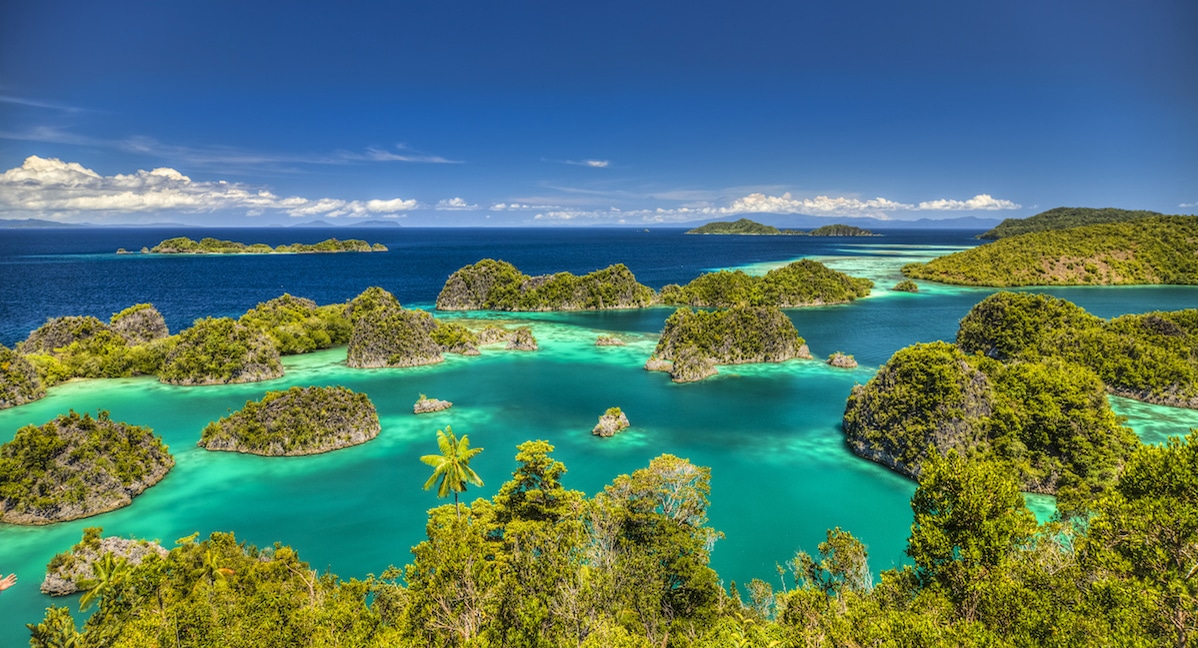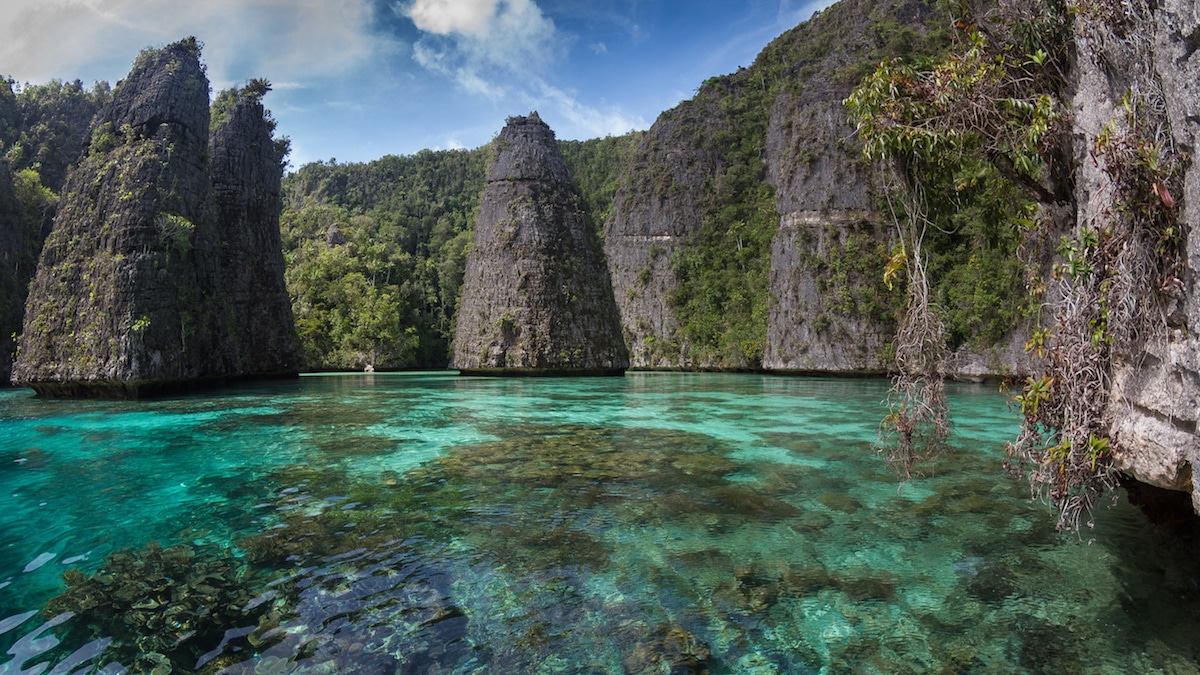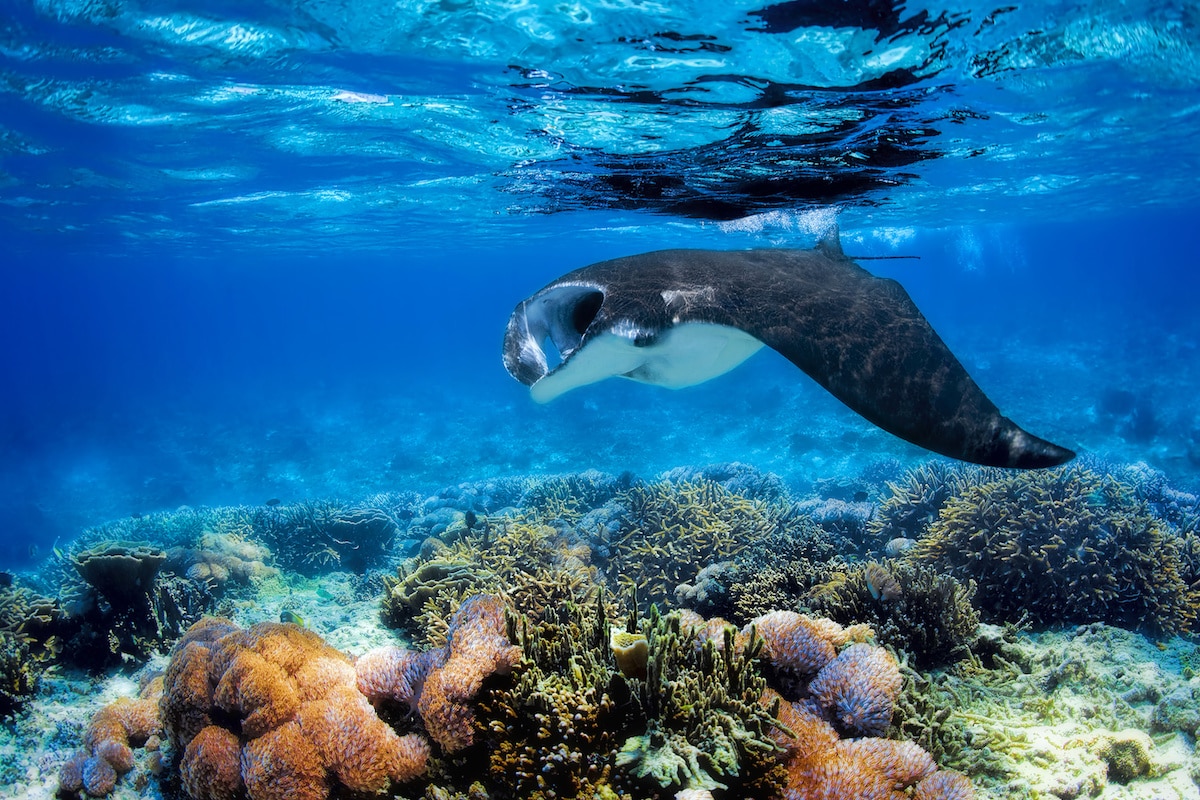News
5 Great Reasons to Visit Raja Ampat

Indonesia, the world’s largest archipelago, has four times more ocean than land and around 13,000 paradise islands to explore. It is one of the best dive destinations in the world to experience a variety of marine life and different dive areas, including the beautiful islands of Raja Ampat. The Raja Ampat season begins in November, so let’s take a look at some great reasons to visit this world-class dive destination.
1) Visit the Most Species-Rich Region on Earth
Raja Ampat is within the most biologically diverse marine region on earth; the coral triangle. This centre of global biodiversity comprises an area that includes Indonesia, Malaysia, Papua New Guinea, the Solomon Islands and Timor-Leste. A dive trip to Raja Ampat is an opportunity to witness a species diversity higher than anywhere else within the coral triangle.
Divers can enjoy an exceptional variety of species when exploring Raja Ampat; from large pelagics to a diverse array of macro life. Over 1500 fish species, 537 species of coral and almost 700 mollusc species have been identified at Raja Ampat so far. Divers can enjoy encounters with sharks, dolphins, mobula rays, manta rays, reef fish, turtles, whales and even non-stinging jellyfish at Misool. It is an ideal dive spot for macro photographers, who can enjoy the exceptional water visibility and light conditions at the colourful reefs. Pygmy seahorses, ghost pipefish and a variety of nudibranchs are often seen.
2) Swim with Whale Sharks, Walking Sharks, Wobbegongs & More
Shark fans can enjoy diving with a variety of sharks at Raja Ampat and the whale sharks of Cenderawasih Bay are not to be missed. This famous dive site is almost completely sheltered from the winds and features one of the best whale shark encounters in Indonesia. The fishermen give fish to the whale sharks to bring luck, and numerous whale sharks can be found there year-round. Cenderawasih Bay is also the location of a number of World War II wrecks, providing an assortment of dive sites.
Epaulette sharks, Indonesia’s famous ‘Walking Sharks’, can be found at Misool – one of the few places in the world where divers can see these sharks and witness their unique walking behaviour. Epaulette sharks can survive extended periods of time with little to no oxygen and use their pectoral fins to ‘walk’ between corals at low tide. They can even be seen walking along the seafloor during dives.
Blacktip and whitetip reef sharks are seen frequently at Raja Ampat and wobbegong sharks are found at Yangelo Island.
3) Sail Raja Ampat’s 1500 Paradise Islands
Imagine sailing amid forest-clad islands and bright turquoise waters, and you’re picturing one of the best ways to explore Raja Ampat. With over 1500 islands scattered across the ocean, you won’t be short of stunning landscapes and white-sand beaches to explore each day.
Indonesia has a rich history of sailing using their traditional phinisi boats; hand-hewn from exotic and rare woods. Phinisi boats were originally used to carry spices and textiles through the ancient spice route and modern phinisi boats are used for cruising and diving. There are a variety of phinisi boats to choose from in Indonesia, as well as sailing and motor yachts, a luxury floating hotel and steel hull boats. Each have their own advantages and are all ideal for a relaxed dive holiday cruising Raja Ampat’s many islands.
The Pearl of Papua is a beautiful luxury sailing liveaboard that offers Raja Ampat cruises all year. The steel-hulled Empress II is ideal for budget-friendly safaris, whilst the True North is the equivalent of a luxury floating hotel.
4) Dive Pristine Heat-Resistant Coral Reefs
Indonesia has some exceptional coral reefs that are thought to be resistant to the effects of coral bleaching. Raja Ampat is no exception to this and is home to more than ten times the number of hard coral species found in the Caribbean. Scientists have discovered many of the coral species found at Raja Ampat are more resistant to rising ocean temperatures than in other areas of the world. This resistance has left some of Raja Ampat’s reefs in almost pristine condition.
Bird Wall at Waigeo Island is a great dive site for coral bommies and Misool has been nicknamed ‘the kaleidoscope’ for its colourful coral reefs. Wofoh Island has one of the best coral wall dives in the area, with a reef wall covered in a colourful mixture of soft and hard corals.
5) Hang Out with Huge Groups of Manta Rays
There is something magical about swimming with manta rays as they glide through the water and Raja Ampat is a great place to dive with these ocean giants. Mantas are frequent visitors to Raja Ampat and can be seen in large groups as they pass over the reefs.
Manta Ridge has several cleaning stations, where divers can see up to 25 manta rays at any one time as they queue to use the cleaning stations. Mansaur is another good dive site for groups of mantas, plus turtles and a variety of fish life. November to April is the best time to visit to see manta rays in large numbers, as the warming water and plankton blooms attract them to the reefs.
This article was written by divers and writers at LiveAboard.com
 Discover liveaboard diving holiday solutions around the world at Liveaboard.com.
Discover liveaboard diving holiday solutions around the world at Liveaboard.com.
Blogs
Northern Red Sea Reefs and Wrecks Trip Report, Part 2: Wall to Wall Wrecks

Jake Davies boards Ghazala Explorer for an unforgettable Red Sea diving experience…
The second day’s diving was a day full of wreck diving at Abu Nuhas, which included the Chrisoula K, Carnatic, and Ghiannis D. The first dive of the day was onto the Chrisoula K, also known as the wreck of tiles. The 98m vessel remains largely intact where she was loaded with tiles which can be seen throughout the hold. The stern sits at 26m and the bow just below the surface. One of the highlights of the wreck is heading inside and seeing the workroom where the machinery used for cutting the tiles are perfectly intact. The bow provided some relaxing scenery as the bright sunlight highlighted the colours of the soft coral reef and the many reef fish.

Following breakfast, we then headed to the next wreck, which was the Carnatic. The Carnatic is an 89.9m sail steamer vessel that was built in Britain back in 1862. She ran aground on the reef back in 1869 and remains at 27m. At the time, she was carrying a range of items, including 40,000 sterling in gold. An impressive wreck where much of the superstructure remains, and the two large masts lay on the seafloor. The wooden ribs of the hull provide structures for lots of soft corals, and into the stern section, the light beams through, bouncing off the large shoals of glass fish that can be found using the structure as shelter from the larger predators that are found outside of the wreck.

The final wreck at Abu Nuhas was the Ghiannis D, originally called ‘Shoyo Maru,’ which was 99.5m long and built in Japan back in 1969 before becoming a Greek-registered cargo ship in 1980. The ship then ran aground on the reef on April 19th, 1983, and now sits at the bottom at a depth of 27m. Heading down the line, the stern of the ship remains in good condition compared to the rest of the hull. The highlight of the wreck, though, is heading into the stern section and down the flights of stairs to enter the engine room, which remains in good condition and is definitely worth exploring. After exploring the interior section of the ship, we then headed over to see the rest of the superstructure, where it’s particularly interesting to see the large table corals that have grown at the bow relatively quickly considering the date the ship sank. After surfacing and enjoying some afternoon snacks, we made sure everything was strapped down and secured as we would be heading north and crossing the Gulf of Suez, where the winds were still creating plenty of chop.

The next morning, it was a short hop to Ras Mohammed Nature Reserve for the next couple of days of diving. The 6am wake-up call came along with the briefing for the first site we would be diving, which was Shark & Yolanda. The low current conditions allowed us to start the dive at Anemone City, where we would drift along the steep, coral-filled wall. These dives involved drifts, as mooring in Ras Mohammed wasn’t allowed to protect the reefs. As a dive site, Shark & Yolanda is well-known and historically had a lot of sharks, but unfortunately not so many in recent years, especially not so early in the season. However, there was always a chance when looking out into the blue.

The gentle drift took us along the steep walls of the site, with plenty of anemone fish to be seen and a huge variety of corals. It wasn’t long into the dive before we were accompanied by a hawksbill turtle, who drifted with us between the two atolls before parting ways. Between the two reefs, the shallow patch with parts of coral heads surrounded by sand provided the chance to see a few blue-spotted stingrays that were mainly resting underneath the corals and are always a pleasure to see. With this being the morning dive, the early sunlight lit up the walls, providing tranquil moments. Looking out into the blue, there was very little to be seen, but a small shoal of batfish shimmering underneath the sunlight was a moment to capture as we watched them swim by as they watched us.

Towards the end of the dive, we stopped at the wreck of the Jolanda where the seafloor was scattered with toilets from the containers it was carrying. This provided a unique site to make a safety stop, which was also accompanied by a large barracuda slowly swimming by, along with a hawksbill turtle calmly swimming over the reef as the sun rays danced in the distance.
For the next dive, we headed north to the Strait of Tiran to explore the reefs situated between Tiran Island and Sharm El Sheik, which were named after the British divers who had found them. We started on Jackson before heading to Gordons Reef, where we also did the night dive. All the atolls at these sites provided stunning, bustling coral reefs close to the surface and steep walls to swim along, which always provided the opportunity to keep an eye out for some of the larger species that can be seen in the blue. Midwater around Jackson Reef was filled with red-toothed triggerfish and shoals of banner fish, which at times were so dense that you couldn’t see into the blue. Moments went by peacefully as we enjoyed the slow drift above the reef, watching these shoals swim around under the mid-afternoon sun.

The night dive at Gordon’s Reef was mainly among the stacks of corals surrounded by sand, which was great to explore under the darkness. After some time circling the corals, we came across what we were really hoping to find, and that was an octopus hunting on the reef. We spent the majority of the dive just watching it crawl among the reef, blending into its changing surroundings through changes in colour and skin texture. It’s always so fascinating and captivating to watch these incredibly intelligent animals, in awe of their ability to carry out these physical changes to perfectly blend into the reef. Before we knew it, it was time to head back to the boat to enjoy a well-deserved tasty dinner prepared by the talented chefs onboard.
Check in for the 3rd and final part of this series from Jake tomorrow!
To find out more about the Northern Red Sea reef and wrecks itineraries aboard Ghazala Explorer, or to book, contact Scuba Travel now:
Email: dive@scubatravel.com
Tel: +44 (0)1483 411590
Photos: Jake Davies / Avalon.Red
Marine Life & Conservation
Double Bubble for Basking Sharks

 The Shark Trust is excited to announce that, for two more days only, all donations, large or small, will be doubled in the Big Give Green Match Fund!
The Shark Trust is excited to announce that, for two more days only, all donations, large or small, will be doubled in the Big Give Green Match Fund!
Donate to Basking in Nature: Sighting Giants
The Shark Trust is hoping to raise £10k which will be doubled to £20k. This will go towards Basking in Nature: Sighting Giants. And they need YOUR help to reach they’re goal.
The Shark Trust’s citizen science project is to monitor and assess basking sharks through sightings; encouraging data collection, community engagement, and promoting nature accessibility. This initiative aims to enhance health and wellbeing by fostering a deeper connection with British Sharks.
Campaign Aims
- Increase citizen science reporting of Basking Sharks and other shark sightings to help inform shark and ray conservation.
- Provide educational talks about the diverse range of sharks and rays in British waters and accessible identification guides!
- Create engaging and fun information panels on how to ID the amazing sharks and rays we have on our doorstep! These can be used on coastal paths around the Southwest. With activities and information on how you can make a difference for sharks and rays!
- Promote mental wellbeing through increasing time in nature and discovering the wonders beneath the waves!
Donate, and double your impact. Click Here
-

 News3 months ago
News3 months agoHone your underwater photography skills with Alphamarine Photography at Red Sea Diving Safari in March
-

 News3 months ago
News3 months agoCapturing Critters in Lembeh Underwater Photography Workshop 2024: Event Roundup
-

 Marine Life & Conservation Blogs2 months ago
Marine Life & Conservation Blogs2 months agoCreature Feature: Swell Sharks
-

 Blogs2 months ago
Blogs2 months agoMurex Resorts: Passport to Paradise!
-

 Blogs2 months ago
Blogs2 months agoDiver Discovering Whale Skeletons Beneath Ice Judged World’s Best Underwater Photograph
-

 Gear Reviews2 months ago
Gear Reviews2 months agoGear Review: Oceanic+ Dive Housing for iPhone
-

 Marine Life & Conservation2 months ago
Marine Life & Conservation2 months agoSave the Manatee Club launches brand new webcams at Silver Springs State Park, Florida
-

 News3 months ago
News3 months agoWorld’s Best Underwater Photographers Unveil Breathtaking Images at World Shootout 2023




















